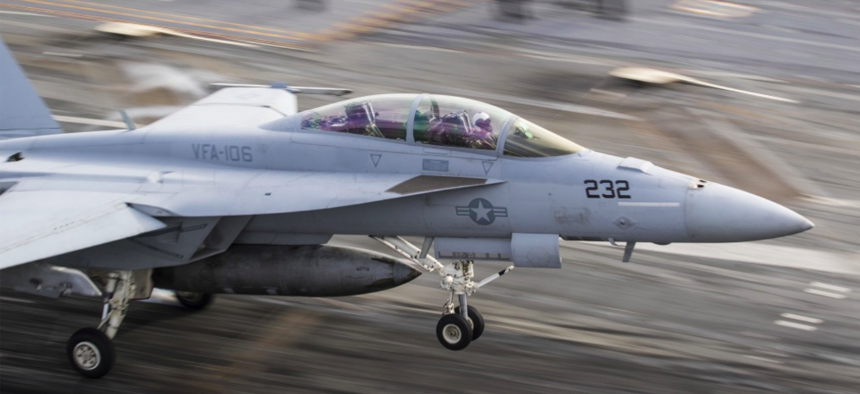
An F/A18 Super Hornet, assigned to the Romans of Strike Fighter Squadron (VFA) 106, lands on the flight deck of the aircraft carrier USS George Washington (CVN 73). U.S. Navy Photo by Petty Officer Jacob Goff
America's Fighter Jet Makers Are Thriving, Thanks to Trump and Putin
Orders of older warplanes surge as U.S. military spending rises and Russia rattles its sabers.
American-made fighter jets, once facing extinction, have seen a resurgence in sales, thanks largely to Donald Trump and Vladimir Putin. Add to that Middle Eastern nations arming for potential war with Iran and there may be more than $80 billion in new or potential sales for F-15s, F-16s, and F/A-18s worldwide.
Trump’s Pentagon budgets over the past two years have enabled the U.S. Navy to keep buying new F/A-18 Super Hornets. His fiscal 2020 budget plan calls for purchasing even more of those warplanes, plus a new variant of the F-15 for the Air Force, which has not purchased Eagles since 2001. Meanwhile, eastern European nations spooked by Russia’s 2014 annexation of Crimea are looking at the affordable F-16.
Three years ago, just one U.S. fighter jet was expected to still be in production next year: Lockheed Martin’s F-35 Joint Strike Fighter, a warplane being built for the U.S. military and a growing number of its allies.
“[W]e basically thought the [F-16] line was finished,” Lockheed CFO Ken Possenriede said March 7 at a JP Morgan investors conference in New York.
Related: Lockheed Unveils F-21 Fighter, a Beefy F-16 Concept It’s Pitching to India
Related: This Stealthy Drone May Be The Future of Russian Fighter Jets
Related: Boeing Is Pitching the US a New F-15, Using Its Super Hornet Game Plan
But then new orders started coming in for the venerable jet, which first flew in 1974. Last year, Bahrain ordered 16 planes. Lockheed is negotiating with Slovakia for 14 jets, Possenriede said. Bulgaria is in talks to buy eight jets and Romania is considering buying three dozen used F-16s.
“There are other countries out there that are interested,” Possenriede said. “Indonesia. Morocco. Taiwan is interested.”
While some western European governments are buying new F-35 Joint Strike Fighters, smaller countries in eastern Europe are eyeing new and used F-16s. The single-engine jets are seen as an affordable way to beef up their militaries against Russian aggression, and to phase out aging Soviet-made warplanes.
“F-16 international opportunity may be under-appreciated, though equally, if [Defense Department] orders Boeing’s F-15X, we don’t see that as a benign development for the F-35,” Byron Callan, an analyst with Capital Alpha Partners, wrote in a Feb. 10 note to investors.
With F-16 orders dwindling and F-35 orders on the rise, Lockheed moved its F-16 factory from Fort Worth, Texas, to Greenville, South Carolina. Bahrain will receive its first F-16 — from that production line — in 2021, Possenriede said.
“Then … in the foreseeable future you’ll see us deliver about eight aircraft a year,” he said. “I think we’re in good shape for awhile.”
The Greenville F-16 production line has a capacity to build about four planes per month, according to John Losinger, a Lockheed spokesman.
There’s a similar story in St. Louis, where Boeing makes the F-15 and F/A-18. In 2015, the F/A-18 production line slowed to two planes a month while the Pentagon decided whether to place new orders. The answer was yes, and the line has remained open at that pace ever since.
In fiscal 2018 and 2019, the Navy received a total of $3.7 billion to buy 24 Super Hornets. The 2020 budget request, sent to Congress last week, asks for $1.8 billion for 24 more jets. The future-years budget plan predicts even more purchases, though more slowly: 60 F/A-18s between 2021 and 2024, according to Pentagon spending documents.
But these orders, coupled with Navy contracts to extend the lives of its Super Hornets, will keep Boeing’s production line flowing through 2034, company spokesman Justin Gibson said.
There’s also the international market. Last year, Kuwait ordered 28 Super Hornets, the first of which are to arrive by December. Finland is considering new Super Hornets (as well as the F-35 and other European-made aircraft) to replace its older Hornets in a deal that could be worth $13 billion. Germany is considering the Super Hornet to replace its fleet of 90 Tornado jets.
Then there’s the F-15. Last week’s Pentagon budget request includes $1.1 billion to buy eight of the new F-15EX variant. If lawmakers approve, it would be the first U.S. Air Force order of an F-15 in nearly two decades. And the budget plan calls for buying 72 more F-15EXs between 2021 and 2024 for $6.8 billion.
The Eagle has drawn interest overseas as well. Beside the Saudi order, Qatar agreed in 2017 to order 36 F-15s, the first of which is expected to arrive in 2021. Israel is also reportedly considering an order of new F-15s.
Then there’s India’s long-awaited, long-delayed plan to buy 114 new jets for around $15 billion. Among the contenders are Boeing’s Super Hornet and Lockheed’s updated, rebranded F-16 called the F-21.
[O]bviously the big one is India,” Possenriede siad.
Related podcast:




